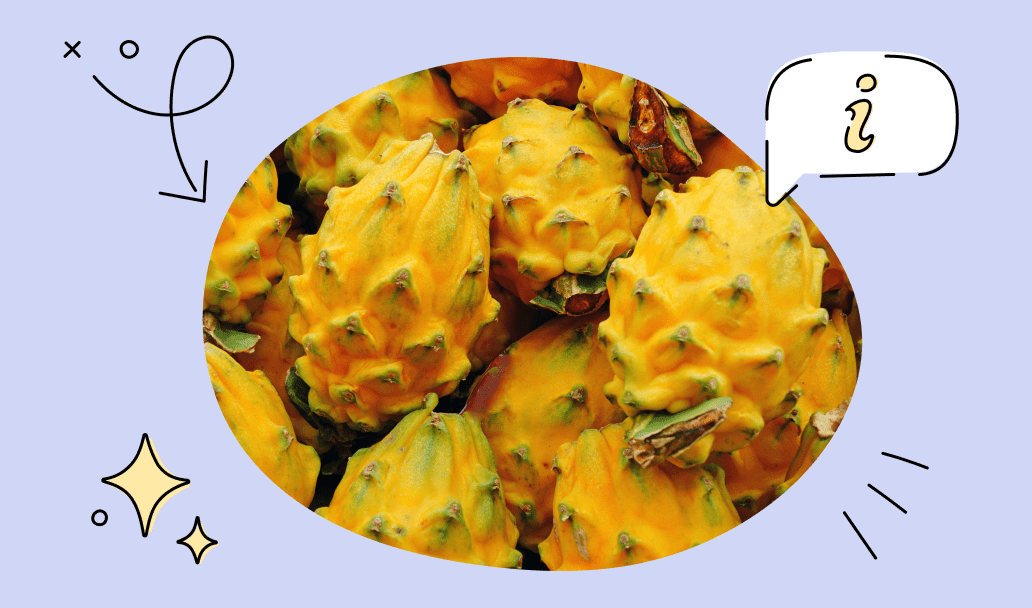Most of us are familiar with red dragon fruit, but have you ever heard of yellow dragon fruit? Known by many names, this exotic and highly-nutritious fruit is a delicious snack you can incorporate into your everyday eating plan. Find out more about the benefits of yellow dragon fruit and how to eat it below.
Most of us are familiar with red dragon fruit, but have you ever heard of yellow dragon fruit? Known by many names, this exotic and highly-nutritious fruit is a delicious snack you can incorporate into your everyday eating plan. Find out more about the benefits of yellow dragon fruit and how to eat it below.
Yellow dragon fruit is an exotic-looking fruit similar to red dragon fruit. Yellow dragon fruit is also called la pitahaya, cactus fruit, strawberry pear, or pitaya.This fascinating fruit has a refreshing and sweet taste, reminiscent of a mix of kiwi, watermelon, and pear.
Eat tasty food and lose weight with Unimeal app!
Take a Quiz – Get personal meal plan – Achieve your weight goals!
Start QuizYellow dragon fruit is less round and has more of an egg-shaped appearance. When it’s ripe, it has a textured bright yellow skin with a soft white inside and small black pips. On average, yellow dragon fruit is about ten centimeters long and seven centimeters wide.
If you were wondering if you could eat it, you most definitely can! The sweet, tropical flavor is to die for and leaves you feeling refreshed and quenched.

The sugar content is relatively high, but the yellow dragon fruit remains a healthy option. In one 6 oz serving of dragon fruit flesh, you’ll find the following nutrients1American Department of Agriculture. 2021. Food Data Central: Yellow Dragon Fruit. Usda.gov. Retrieved from https://ndb.nal.usda.gov/ndb/foods/show/45291867:
Expert comment

Written by Ievgeniia Dobrynina
Ievgeniia Dobrynina is the Head of Nutrition and a fact checker at Unimeal.
In terms of nutritional value, I can compare this fruit with mango (although mango is lower in calories). This fruit is wonderful and very healthy (the fact that it contains iron, which is so necessary for modern people during the era of massive iron deficiency anemia, is especially pleasing). Also, this fruit is quite satiating, so it can be a good snack. But given the relatively high-calorie content and amount of sugar in one fruit, you should not rely on it if you want to lose weight. You can eat it within the limits of your daily calorie allowance, preferably in the first half of the day.

If you’re considering adding a food to your eating plan that offers numerous health benefits, you’ve just struck gold! Yellow dragon fruit is rich in fiber, iron, antioxidants, and heatlhy fats.

Yellow dragon fruit has few side effects, but it’s important to know what they are in case you experience one of them.
Some say the skin of yellow dragon fruit is edible, and some say it isn’t. Whichever way, it poses a risk of being toxic due to pesticides, so it’s better not to eat the outer layer.
There is also a high sugar risk as yellow dragon fruit contains 13g of sugar per 6 oz. Be mindful of this and consume the fruit in moderation to benefit from all the nutrients it offers.
Finally, there is a minimal chance that you may have an allergic reaction; however, this is very rare. If you experience your tongue swelling, rather avoid yellow dragon fruit.6Kleinheinz, Andreas & Lepp, Ute & Hausen, Björn & Petersen, Arnd & Becker, Wolf-Meinhard. 2009. Anaphylactic reaction to (mixed) fruit juice containing dragon fruit. The Journal of allergy and clinical immunology. DOI:10.1016/j.jaci.2009.05.025

The main secret to preparing the best yellow dragon fruit lies in how to pick yellow dragon fruit - you need to choose one that is ripe and bright yellow. Here are the simple steps to enjoy fresh yellow dragon fruit:
Because of its refreshing taste, you can add yellow dragon fruit to your yogurt bowl, use it in smoothies, and even add it to salads for an exciting taste sensation.

Apart from their colors, yellow and red dragon fruit look deceptively similar. However, there are some key differences between the two.
First, yellow dragon fruit has white flesh, while red dragon fruit has deep, dark red flesh. Yellow dragon fruit also has tiny seeds, while red dragon fruit has larger ones. Taste-wise, the yellow dragon fruit will be much sweeter as it contains up to 10% more sugar than red dragon fruit.

Whether you choose yellow or red dragon fruit, you're sure to find them nutritious additions to a healthy and balanced diet. Yellow dragon fruit, however, contains loads of antioxidants, high levels of iron, and healthy fats that benefit your heart, hair, skin, and immune system.
Be sure to try yellow dragon fruit when you spot it at your local grocer. You won't be disappointed!
Unimeal does not diagnose or suggest treatments. Any description of the diet, training plan or supplement should be discussed with your current physician or nutritionist. This article does not address specific conditions and is simply meant to provide general information on healthcare topics. Following any advice is at your own initiative and does not impose any responsibility on the blog authors for your health and safety.
Sources:
By choosing high-quality sources, we make sure that all articles on the Unimeal blog are reliable and trustworthy. Learn more about our editorial processes.
1.
2.
3.
4.
5.
6.
Related Articles